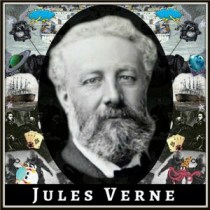How well do you know Jules Verne? – Here’s a short quiz to find out. Have fun. 🙂

~ Jules Verne ~
Question 1 |
In the book Around the World in Eighty Days which of the following was not a mean of transportation Phileas Fogg and Passepartout used to make it back to London in time to win the bet?
train | |
steamship | |
elephant ride | |
hot air balloon |
Question 1 Explanation:
During their journey, Phileas Fogg and Passpartout never used a hot air balloon. Many first time readers are surprised to learn this fact, especially since several editions of "Around the World in Eighty Days" show a large balloon on the front cover.
Question 2 |
How many yachts did Jules Verne own throughout his lifetime?
1 | |
2 | |
3 | |
Jules Verne never owned a yacht. |
Question 2 Explanation:
Jules Verne owned a total of three yachts during his life time. He bought his first one in 1868, when he was forty years old, and named it Saint Michael after his only son. The next two yachts were called Saint Michael II and Saint Michael III.
Question 3 |
True or false: Jules Verne's work was blessed by Pope Leo XIII.
true | |
false |
Question 3 Explanation:
True.
In 1884, Jules Verne traveled to Italy and Pope Leo XIII personally blessed his work.
Question 4 |
Which of the following places did Jules Verne travel to in 1867?
Rome, Italy | |
Madrid, Spain | |
Dublin, Ireland | |
Niagara Falls, USA |
Question 4 Explanation:
In 1867, Jules Verne traveled to New York with his younger brother, Paul, aboard British steamship The Great Eastern.
According to Verne's friend Adrien Marx, Jules Verne "accomplished his voyage in ninety-six days. On reaching New York, he did not saunter about Broadway, looking in shop-windows, but took the railway and went six hundred leagues to see Niagara Falls, of which he cannot yet [ten years later] speak without emotion."
Question 5 |
Which of the following health conditions did Jules Verne not suffer from?
multiple fracture of right arm following boating accident | |
diabetes | |
permanent limp after being shot in the leg | |
episodes of facial paralysis |
Question 5 Explanation:
Jules Verne suffered from facial paralysis due to inflammation of the middle ear, had a limp after being shot in the leg by his favorite but mentally deranged nephew, and died of complications from diabetes.
There are no records of him having fractured any bones during boating accidents.
Question 6 |
Which of the following writers did Jules Verne not collaborate with, early in his writing career?
Alexandre Dumas (father), author of "The Three Musketeers" | |
H. G. Wells, author of "The Time Machine" | |
Michel Carre, prolific author of libretti | |
Alexandre Dumas (son), author of "Camille" |
Question 6 Explanation:
Although he was studying in Paris for his law degree, Jules Verne wanted to become a writer and, early in his career, briefly collaborated with Alexandre Dumas (both the father and the son) and Michel Carre.
He never worked with H.G.Wells.
Question 7 |
True or false: Jules Verne believed both his and H.G. Wells's stories belonged to the same genre: science-fiction.
true | |
false |
Question 7 Explanation:
False.
Jules Verne believed the inventions in his books were possible based on the laws of physics and the technology known at the time. When asked about H.G.Wells's stories, Verne called their inventions either impossible, either belonging to a future far removed from his present.
In his own eyes, Jules Verne was a writer of science-possible whereas H.G.Wells was a writer of science-fiction.
Question 8 |
Which of the following is not true of Jules Verne's professional life?
he studied law and intended to become an attorney | |
he wrote poems and plays | |
he worked as a stockbroker | |
he worked as a curator in the Decorative Arts department of the Louvre Museum |
Question 8 Explanation:
Jules Verne studied to become an attorney (at his father's request), wrote poems and plays early in his career, and even worked as a stockbroker to support himself and his wife.
He never worked at the Louvre.
Question 9 |
Which Jules Verne character said, "We may brave human laws, but we cannot resist natural ones?"
Professor Otto Lidenbrock in "Journey to the Center of the Earth" | |
Captain Nemo in "Twenty Thousand Leagues Under the Sea" | |
Phileas Fogg in "Around the World in Eighty Days" | |
Captain John Hatteras in "The Adventures of Captain Hatteras" |
Question 9 Explanation:
Captain Nemo.
That line was part of his answer to Professor Aronnax on why Nautilus had stranded. In Captain's Nemo words, the accident resulted "from a caprice of nature, not from the ignorance of man." He went on, saying, "Not a mistake has been made in the working, but we cannot prevent equilibrium from producing its effects. We may brave human laws but we cannot resist natural ones."
Question 10 |
True or false: Jules Verne is the third most translated author in the world, right after William Shakespeare and Agatha Christie.
true | |
false |
Question 10 Explanation:
False.
Jules Verne is the second most translated author in the world, behind Agatha Christie and ahead of William Shakespeare.
There are 10 questions to complete.
Further Reading and a Quiz
Find facts, anecdotes, and videos about Jules Verne at the links listed below:
1. Jules Verne – A Short Biography
2. Jules Verne at a Glance – Infographic
3. Jules Verne Was Born In 1828 – What Else Happened That Year? (blog post or infographic)
4. Jules Verne at Niagara Falls, Jules Verne vs. H.G. Wells, and Two More Stories
5. Jules Verne Video – “In 30 Seconds or Less” Series